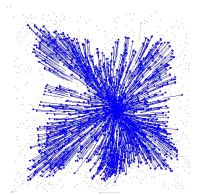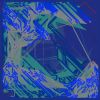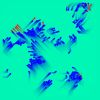Videoplayer
The videos shown here were produced using self-developed software that simulates certain forms of swarm intelligence.
The movements and behavior of the swarm members (so-called boids) are then
the consequence of the interactions between the boids, which apply their swarm rules and thereby lead
to the overall picture of the swarm with its swarm movements, formation of sub-swarms and dissolution
of sub-swarms.
Some of the videos are in the style of Op Art. The video "Playing with Nails" also uses structures
that are supposed to be reminiscent of Günther Ueker’s nails. The high dynamics in this video is a result
of the emergence and decay of structures in the style of futurism, reflecting the interaction of the swarm members.
The swarm rules used in these videos are based on an untimed Java applet released in 2015. The videos
show short excerpts from this. The use of rules for swarm intelligence means that the flow of movement
of the swarm members is not predictable, but always arises dynamically through the interaction of
the boids with each other.
From the perspective of some monistic philosophies, boids can be considered to have a limited type of
consciousness. In the schools of Tibetan Buddhism, the so-called 5 Skandha are described as the basis for the
presence of consciousness and the so-called Dharmakaya for unconscious, spontaneous action.
The 5 Skandha describe the experiences of humans and animals:
Video starts after clicking on an image with a delay of about 10 seconds
new: February 2024
Swarm intelligence creates moving nails in the style of Guenther Uecker
(0:37 min)

By applying the swarm rules discovered by Craig Reynolds,
the swarm members (so-called Boids)
were induced to organize themselves into sub-swarms.
The nail head corresponds to the center of a virtual neighborhood group. The nails indicate the planned
direction of movement of neighborhood groups. The actual swarm members (Boids) are symbolized by the small red lines.
The locations of green symbols are locations where Boid collisions occurred. The high level of dynamism reflects the
emergence and decline of neighborhood groups.
Information on the swarm rules and examples of swarm simulations can be found here:
Swarm Simulations
Swarm intelligence creates moving lines in the OP-Art style
produced in June 2022 (1:07 min)

The video was created by applying the swarm rules discovered by Craig Reynolds,
where the movements of the swarm members (so-called Boids) are represented as line structures.
Swarm intelligence creates coloured stripes in the OP-Art style
(1:23 min) January 2024

Also this video was created by applying the swarm rules from Craig Reynolds,
where the movements of the swarm members (so-called Boids) are represented as stripes.
Swarm intelligence creates circular areas in the OP-Art style
(1:10 min) January 2024

This video was also created by applying the swarm rules discovered by Craig Reynolds,
where the movements of the swarm members (called Boids) were generated by these swarm rules
and the circle diameters are based on neighborhood relationships.
Swarm intelligence creates grubs and worms in the OP-Art style
(1:00 min) January 2024

This video was also created using swarm rules,
where the movements of the swarm members (Boids) were generated by these swarm rules
and the line-shaped structures indicate the influence of neighboring Boids.